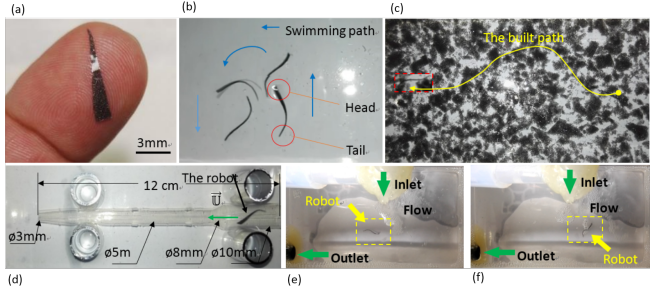
Untethered small-scaled magnetic robots are promising in biomedical applications. However, the property and locomotion of these tiny robots remain challenges to fulfill the purpose of minimally invasive medicines in biological region.
Due to the development of materials and functional integrations, the transition of structure from hard to soft is able to enhance capabilities of the robot, e.g. soft interface and no harm interaction.
Researchers from the Shenzhen Institutes of Advanced Technology (SIAT) of the Chinese Academy of Sciences fabricated a swimming soft film robot through magnetic elastomer, which may shed light on diverse applications of biomedicines.
The magnetic soft robot with the triangular head-tail morphology and sine-based magnetization utilized a high degree of freedom provided by magnetic compliance for mobility in a form of lateral undulation.
In fluid, the pressure gradient generated by the undulating robot could enhance the swimming performance. A low-pressure region was produced around its body surface, and a high-pressure region was produced around its head. Due to the distinguish pressure, the racing fluid from the high to low region pulled the robot through.
With this novel design, the fabricated robot could achieve self-propulsion by body-wave propagation under the driving of oscillating magnetic field, similar to eel’s slithering.
The deformation degree and magnetic response of the robot was tunable due to the property of non-uniform magnetic strength. Thus, varying the magnitude of the actuating magnetic field and frequency could empower and adjust the robot's performance.
The feasibility of the robots was validated and confirmed experimentally in diverse environmental conditions that mimic complex and unstructured biological regions, such as the vessel where blood flow is violent, and the cerebral fluid where flow rate is slower.
The researchers found that the robot could exert the force rate to push out surrounding fabrics heavier than itself for the self-built path in the granular-like media, and it could swim against the flow of fluid by gaining the frequency of the body-wave undulation for faster swimming speed.
The study entitled "Magnetic soft robot with the triangular head-tail morphology inspired by lateral undulation" was published in ASME/ IEEE transactions on Mechatronics and recommended by the technical editor of the journal.

Fig. (a) Specifications of the robot; (b) Free undulation of the robot in viscous fluid (10mm2.s-1); (c) Force transfer of the undulating robot to the fabric media; (d) Adjustable amplitude of the undulating robot in tubes; (e) and(f) Undulation of the robot in the flow (Image by SIAT)
Capabilities of the proposed magnetic soft robot (Video by SIAT)

86-10-68597521 (day)
86-10-68597289 (night)

52 Sanlihe Rd., Xicheng District,
Beijing, China (100864)

